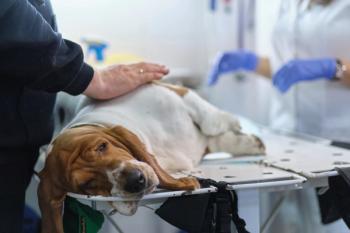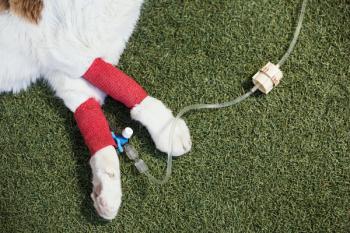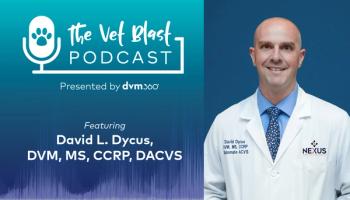
Rehabilitation gives animals swifter road to recovery, DVM says
Physical rehabilitation techniques go a long way toward helping animals after surgery.
Physical rehabilitation techniques go a long way toward helping animals regain use of limbs following surgery and speed the process. While that may be the most obvious, it is not the sole benefit of such therapy.
Dr. Darryl L. Millis, professor of orthopedic surgery and director of surgical services in the Department of Small Animal Clinical Sciences at the University of Tennessee in Knoxville, discusses other benefits of rehab therapy, latest trends in the field and even explodes a myth in the following question-and-answer session with DVM Newsmagazine.
Millis' general clinical interest is in small-animal orthopedic surgery and physical rehabilitation. His research interests include modulation of bone healing, osteoarthritis and post-operative physical therapy of orthopedic patients.
Millis earned his DVM degree from Cornell University and completed a small-animal internship and surgery residency at Michigan State University. He is a Diplomate of the American College of Veterinary Surgeons.
Based on research he has conducted since 1985, Millis has published more than 120 peer-reviewed articles in numerous journals. He is co-editor of the book, Canine Rehabilitation and Physical Therapy (2004).
Q. When dealing with physical rehabilitation in small-animal patients, what is the most significant challenge for general practitioners?
A. The knowledge and (lack of) education. To date, physical rehabilitation is not something that's taught in veterinary schools to a large extent. In larger veterinary schools and even some smaller programs, students may be exposed to lectures on rehabilitation.
But when you consider what is involved in obtaining a master's in physical rehabilitation, you realize that a lot isn't covered in the schools.
I've had interest in animal rehabilitation since I was on faculty at Mississippi State back in 1991. I noticed that animals treated with rehabilitation modalities used at that time recovered better than what I was used to. In the 1950s and 1960s, if a football player tore his cruciate ligament, you may as well have considered his career nearly over. These days, it's considered a treatment failure if the person doesn't get back to function after such an injury. The same is true in the animal realm.
Q. You have research interests in modulation of bone healing, osteoarthritis and postoperative physical therapy of orthopedic patients. Can you speak to some of the important trends in each of these areas?
A. Osteoarthritis is a huge area. The pharmaceutical companies have jumped on that big-time because of the number of dogs with osteoarthritis. You can even find a significant volume of popular press information on human nonsteroidal therapies as well as other COX-2 inhibitors. People have increasing concerns about long-term use of NSAIDs, which has opened up a new realm of treatment for dogs, including physical therapy and extracorporeal shockwave therapy, for example.
The multimodal approach to therapy is new. The current work being done with stem-cell therapy is interesting. It's definitely on the cusp of gaining popularity.
The challenge is to determine how to combine one therapy with other treatments to make the outcome more impressive. Part of the problem is lack of funding and evidence-based research to evaluate all of the methods and products entering the market. But that trend is starting to change.
Q. If you had one longstanding myth to bust about small-animal orthopedic surgery, what might it be?
A. A good one — and I still hear this today — is that I will hear practitioners say, "My patients do so well after surgery that they don't need rehabilitation."
My question is, will they do as well, or as quickly as they would have, had rehabilitation been used as part of the treatment?
Q. Is the overlap between human and animal physical rehabilitation relevant?
A. Yes, it's very relevant. Obviously there are differences between human and animal therapy. One of the biggest is the realization that animal therapy is probably more like pediatrics, where the baby can't verbalize what's happening. But much of the basic scientific work for human rehabilitation was done on dogs. In turn, the model work done on animals has application for those of us in veterinary medicine, along with contributing to clinical applications with humans.
Q. As the pet population ages, what breeds (dogs and cats) are most susceptible to orthopedic conditions?
A. Large and giant breeds all have problems as they age, including cruciate rupture, hip dysplasia, etc. We're seeing a whole new realm of injuries that probably existed to some degree before. However, with better diagnostic techniques, such as MRIs, we can identify more soft-tissue disease in agility dogs for example. The possibilities for medical treatment are increasing.
Q. What are some of the most significant benefits of physical therapy?
A. Some immediate benefits are reduced pain, earlier and better use of the limb and fewer deleterious changes, such as bone atrophy or weakening of ligaments and tendons. All of these issues are prominent without rehabilitation and can be devastating.
Prevention is key with recovery. You want to improve limb use and improve function, and the amount of activity is key to these improvements.
More practitioners are beginning to realize the benefits of such therapy. Also, from a consumer standpoint, the popular press and magazines are realizing that more of this therapy is being done on behalf of animals. As a result, more consumers are asking the practitioner, "What about rehabilitation?" Many have had rehab themselves, and it makes sense to them.
Q. Any other comments?
A. In terms of education, I'd like to mention that the University of Tennessee has a certificate program in canine rehabilitation that veterinarians, veterinary technicians and physical therapists can go through to gain more education on the modality.
Newsletter
From exam room tips to practice management insights, get trusted veterinary news delivered straight to your inbox—subscribe to dvm360.





